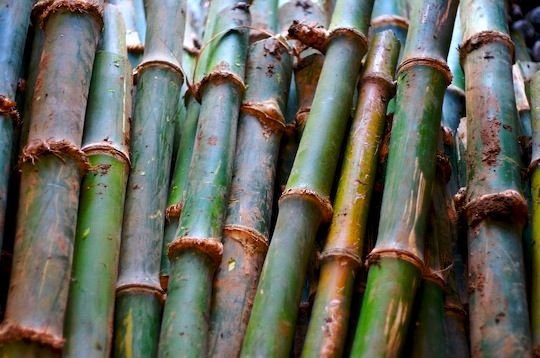
Harvested bamboo, La Union Province.
Background
Narda Capuyan started weaving blankets from recycled acrylic yarns 30 years ago in La Trinidad, Benguet, Philippines and built a mini clothing and craft empire from it. Like many of the entrepreneurs we’ve met on this trip, Narda and her husband Wilson have many businesses going on (see their organic farm, construction company, housing development…eco-tourist villlage), as well as philanthropic endeavours.
Actually, the interesting thing is that most of these people (just like our first project in Palawan last month) often combine the two: business and social welfare programs. I’ve heard the term ‘social entrepeneur’ used.
Project Scope
Before arriving in June there was the vague idea that we would work with Narda’s current weavers in her 50-employee ‘factory’ of looms here in Baguio and maybe come up with some more contemporary designs and stuff. And build them a better website. But we kind of let them know in advance we weren’t as interested in that, so when we arrived they (being Narda, Wilson and cultural expert and friend Dr. David Baradas) simply said we could work with them on anything, and began to list the many things there were up to.
One of those projects is Winaca. Winaca is actually many things and it’s based around this chunk of mountain farm land that Narda and Wilson own and live on near Baguio.
Part of the farm is to be turned into the Winaca Eco Tourist Village where, after they build little cottages dotting the forested areas of the property, people (mostly middle class and rich) can have little get-away vacations of organic food, meditation, herbal healing, massage, dinners at the restaurant, etc.


Wilson Capuyan shows Internship partner Raneen Nosh the construction of a traditional Ifugao home on the Winaca property.
Finally, what is interesting to us is that Winaca will also feature two other things:
1. Ten examples of traditional homes from the 10 ethno-linguistic groups (i.e. tribes) that comprise the still very-present people that make up the entire Cordillera, i.e. mountain region of the Philippines. So far Wilson, who is in charge of this aspect and actually grew up in a tiny hut with his grandmother and six siblings, has already found and physically brought back three examples of housing from three tribes. So these houses will be tourist features but also cultural records of a way of life that is quickly disappearing.
2. An international sustainable design-education centre. Really, this is mostly spurned on by having us two Emily Carr students here, plus expressed interest from a couple other well-known design school.
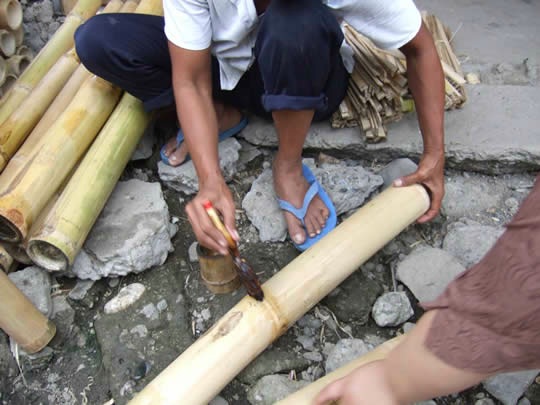
Treating bamboo with kerosene for insect protection. A bamboo furniture maker, during a research tour of the Luzon Low Lands in La Union.
What We Did
As the first students here with Winaca, Raneen and I are actually kicking the thing off by designing and building (with an architect and hired craftspeople) a bamboo residence for the future students who may attend this education retreat on the farm. We’re using bamboo to try and build a showcase home using technology that has been forgotten, as well as western design influences that could contribute ( i.e. where we come in) to try and show people of the region, of all income levels, what sort of architecture is possible outside the current concrete-and-galvanized-iron that dominates the landscape here.
Best case scenario: in the future, design students from all over the Philippines and the world will attend a Winaca retreat for maybe a few weeks or a term, and learn first-hand craft and eco-design things. Also, when locals in the region see how great the bamboo architecture is, and what the students are doing with it, they will want to build their homes in a similar way and get over the stigma attached to bamboo housing (it is associated with the poor, backward farmer) and be more environmentally-friendly all around.
The details of this first phase of the design school—which Raneen and I had full creative and technical control over and basically came up with after just a week here—are to design a bamboo home:
- That uses local, sustainable ( i.e. low true cost, low enviro impact) materials
- That can house four students incl. kitchen, bathroom, living room
- That fuses traditional and contemporary design
- And that will act as a showcase for others to see what potential vernacular ( i.e. for and by the people) architecture has here in Baguio.
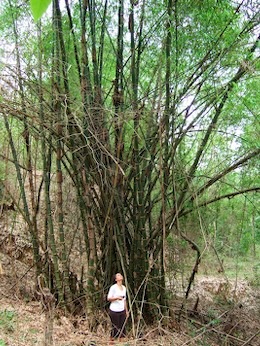

Raneen and the bamboo used for construction. Workers sacrifice a chicken as an offering before breaking ground at the Winaca building site.
And thus during this one month we basically learned as much as we could about bamboo, designed a home, and now the bamboo has already been harvested and the construction has begun. Things move fast here when labour is cheap, you have some capital, and red tape is (for some things) low, i.e. we haven’t heard anyone say anything about any building permits or bylaws or inspectors, etc.
Winaca Intern Report
Raneen and I compiled a final report, intended as an in-depth look at what we learned and designed and as a record for the Winaca Foundation and future students who will continue the project. The report was primarily written and researched by Raneen and laid out by me in InDesign. Three copies were laser printed and bound (saddle staples with a chipboard cover) at Baguio Offset Printing for P700 / copy (about $16 CAN each). The cover type was designed and hand lettered by Summer Artsign for P15 / coy (about 35 cents CAN each).
Download the report:
winaca-report-spreads-screen.pdf [672 KB]
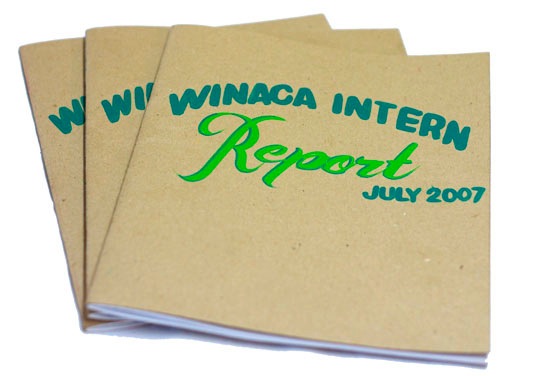
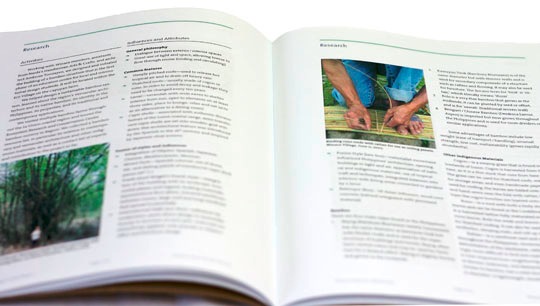
Other Output During Part II
Photography
A collection of about 21 images from over 600 made for this portion of the internship.
Philippines Ukay-Ukay
A description and 1:20 video walkthrough of the used clothing store phenomenon in Baguio City.
Straight Shave
A personal account of having a barber shave me.
Philippines General Design Observations A
A fourth set of various design observations in the Philippines.
Philippines General Design Observations B
A fifth set of various design observations in the Philippines.
Ifugao Hunter Backpack
An excursion to find a traditional Hunter’s Backpack.
I Plug Away in Baguio
A summary of my extra two weeks with Narda’s, making them a website and compiling my internship documentation.
Leave a Reply